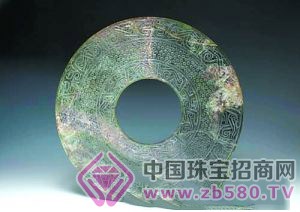
The Museum of Shandong Province, the Great National Monument of Lu State, was unearthed in the Ruins of the Old City of Lu State in 1977. It was a funeral jade in the Warring States period. It has a circumference of 32.8 cm and a diameter of 11.6 cm. It is the largest of the Warring States. One piece. The jade ornaments are beautifully decorated. The enamel ornament is divided into three layers: inner, middle and outer. The inner and outer layers are decorated with two-tailed dragon patterns. The middle area is decorated with grain lines, which symbolizes the beautiful meaning of the grain harvest. The shape of the instrument is regular, the jade is sleek and green, the pattern is compact and symmetrical, the lines are smooth, and the workmanship is exquisite. It provides us with the material information for the study of the jade craft during the Warring States period.
Since ancient times, Yuxi has the meaning of "Cang Li Li Tian". In the design concept of the Shandong Museum building, the meaning is also incorporated into it: the 20-meter-diameter dark green jade-shaped dome inlaid in the center of the first floor lobby is based on this jade. When the sunny sun shines through the jade in the hall, as the light of history traverses, the whole hall will present a splendid and mysterious atmosphere.
As one of the jade rituals, Yuxi first appeared in the Neolithic Age. The most famous record about the artifacts of the jade is the story of the Hessian in the Spring and Autumn Period and the Warring States Period. So what is the shape of the jade? "Said the text" Interpretation: "Ruiyu, round instrument also." "Erya" describes: "Meat is better, it is called ç’§; good times the meat is called ç‘—; meat is good if it is a ring." Here" "Meat" refers to the carcass of the jade, and "good" refers to the round hole in the middle of the jade. In fact, the jade that fully conforms to this standard ratio is rare, so it is summarized in modern language: the jade is an oblate jade. Of course, the shape of the jade is not limited to the oblate shape, and there are other shapes, such as the chain, the outline, and so on.
There are many uses for the jade, and many changes have taken place with the replacement of the dynasty. The jade in the Shang and Zhou dynasties was a special ritual for the aristocratic class. It was used to worship the heavens and also used as a token of the aristocratic symbol. In the Warring States Period and even in the Han Dynasty, due to the decline of the ritual system, Yuxi began to be used as a jade for jade and funeral. In the Song Dynasty, the use of jade was re-emphasized, and the ancient system of use was followed. The styles of the Yuan and Ming Dynasties are mostly antique jade, mostly made of Peiyu and funeral. In the Qing Dynasty, Yuxi was rarely used for burial, but mainly used for offering sacrifices (ceremonies) and playing rewards.
Poly Chiffon Fabric,100% Polyester Chiffon Fabric,Translucent Moss Chiffon,Moss Crepe Chiffon Fabric
Shaoxing DeChuan Textile Co., Ltd. , https://www.dechuantex.com